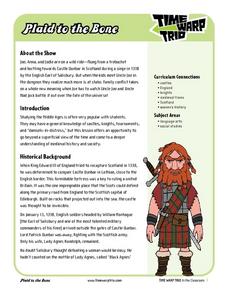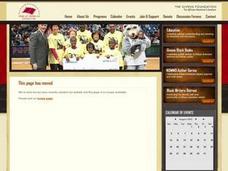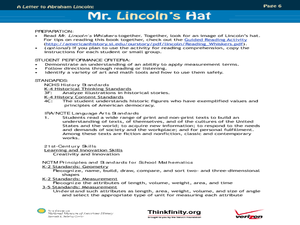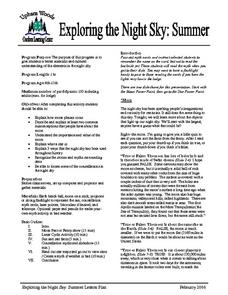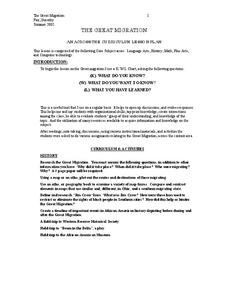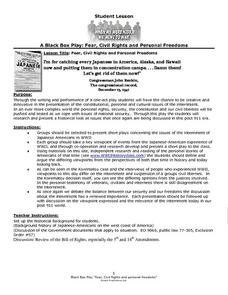Curated OER
Plaid to the Bone
Students study Lady Anges Randolph and other heroic woman using multimedia. They create class presentations with their findings. They write a diary about living in a medieval castle after researching what life was like in them.
Curated OER
Words in the News: Education Bill Backs India's Poor
Students discuss different groups of people who have been discriminated in the history of the world. They practice using new vocabulary words. In groups, they match the word with its definition.
Curated OER
Cells=Life!
Ninth graders share what they know about cells. In this biology instructional activity, 9th graders study different microscopic images of the cell. They draw one and explain to their partner why they chose that image.
Curated OER
How We Get From Here to There
Students recognize various types of movement people rely on to get from one place to another, locate the forms of movement on a map and choose one form of movement and research its path.
Curated OER
Simple Gifts
Pupils examine the concepts of half notes, quarter notes, whole notes, and musical phrases by performing the Shaker song "Simple Gifts". Emphasis is placed on movement with music and meeting national standards for the arts.
Curated OER
50th Anniversary of Brown v. Board of Education
Students examine the Brown v. Board of Education case that ended segregation. They role play to re-enact the case and discuss why it was important. They discover its impact on public education.
National First Ladies' Library
Save the Animals: The Creation of the ASPCA
Students read Black Beauty and study the history of the founding of the ASPCA and learn about endangered species today. Then they write a short paper about the book, or on some aspect of the history of the ASPCA, and, after exploring the...
Curated OER
Australian Aborigine Lizard Painting
Students become familiar with Australian "dot paintings." In this Australian Aboriginal Lizard painting lesson, students make illustration of three types of lizards and complete pictures using "dot painting." Students recognize the...
Curated OER
Investigating Stereotypes
Students study 'stereotype' in literature and life and give examples. they provide examples from life or literature on the origins and impact of stereotypes. they
3. Cite 3 - 5 individual African Americans from literature or life who...
Curated OER
Mr. Lincoln's Hat
Bring out the inner artist with this Abraham Lincoln lesson. Elementary students work on a home project creating a hat similar to Abraham Lincoln's hat. They will use geometry and measurement to create the scale of the hat, then...
Curated OER
Exploring the Night Sky: Summer
Students explain how moon phases occur. They describe and explain at least two common misconceptions that people have about the moon. Students explain what a star is. They explain 3 ways that the night sky has been used throughout history.
Curated OER
Freedom Summer
Students brainstorm and discuss what the concept of "fairness" is and how to identify examples of "fairness." They pull from historical fiction and the Civil Rights Movement to explain how individual are affected by, cope with, and...
Curated OER
The Great Migration: Pushed By The South, Pulled By The North
Students identify key features of the Great Migration. They explain the concepts of push and pull factors for migration. They create an art project which shows an understanding of the push and pull factors.
Curated OER
Designing Medieval Shields
Students design and create a medieval shield. They read and discuss the history and color schemes of how shield symbols are chosen, design and construct an original medieval shield, and write a paragraph explaining the design and symbols...
Curated OER
The Great Migration
Students research the Great Migration and answer questions to discover where it took place, when it took place, who were migrating, and why in a 2 page paper. They use a map or atlas to plot out the routes and destinations of those...
Curated OER
Universal Suffrage
Young scholars explore concept of suffrage. For this voting rights lesson, students participate in a classroom activity that excludes girls from voting. Young scholars discuss gender issues and write essays regarding the restriction of...
Curated OER
Be a Good Egg
Students use an eggshell decay to represent what happens when a person loses someone's trust. In this trust lesson, students discuss decay and complete an eggshell decay activity. Students use the experiment to represent what happens...
Curated OER
Acceptance Through Patchwork
Students are asked to look at differences in people and accept those differences but to examine that people are more alike than different. The lesson has the central focus of investigating diversity.
Curated OER
Fingerprints
Students analyze their fingerprints. In this fingerprint lesson, students make prints and observe the patterns for arches, loops, and whorls. They write a brief autobiography about themselves titled "I'm Thumbody."
Curated OER
Mesoamerican Codex Books
Fifth graders recreate Mesoamerican Codex Books using brown paper bags, paints, glue, an iron, and books on Mesoamerican Glyphs in this 5th grade activity in the Art classroom. Resource links and book references are provided for...
Curated OER
Folktales (African American, Chinese, Japanese and Korean)
Students participate in a variety of activities that are concerned with comparing different cultures through the literary genre of folktales. The stories are used to stimulate student interest and provide a context for how a society...
Curated OER
Making a Mola
Sixth graders explore the term mola. For this social studies lesson, 6th graders create a visual representation of a mola. Additionally, students design their own mola to include important parts of their lifestyle.
Curated OER
Fear, Civil Rights and Personal Freedoms
Students write and perform a one-act play. They present constitutional, personal and cultural issues of the internment camps of the 1940's. They research and present a historical examine internernment camps.
Curated OER
Six Billion and Beyond
Students consider the idea of a world with Six Billion people and subsequent results and ramifications. Then students will gather data regarding the state of these diverse nations and then create a presentation as a culminating activity.


